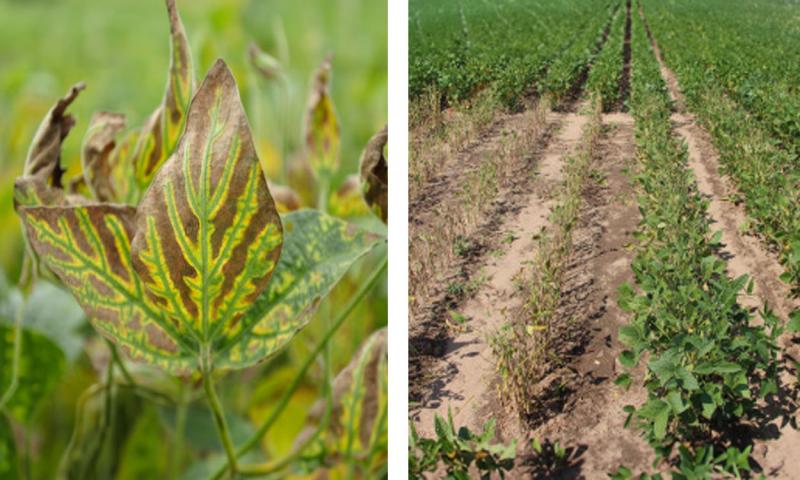Written by Nabina Karki, SDSU Graduate Research Assistant, under the direction and review of Connie Strunk and Madalyn Shires.
Does the current weather condition have you worried about soybean diseases? The present weather conditions of heavy rainfall and cool temperatures provide a favorable environment for the fungal pathogen, Fusarium virguliforme, to infect soybeans with sudden death syndrome.
Sudden death syndrome (abbreviated as SDS) is a soil-borne disease that is currently at high risk of appearing in South Dakota soybean fields. Early planted soybeans are more vulnerable to infection when the soil is compacted and saturated. Disease development can be severe in fields infested with soybean cyst nematodes.
This soil pathogen can survive in infested crop residues or soil for several years. The fungus infects the soybean roots soon after planting. Seedlings are prone to infection when soil conditions are wet and cool. The pathogen causes root rot and produces plant toxins, which move up from the root tissues and develops foliar symptoms.
Symptoms
Infection takes place early in the season, but symptoms are not observed until the plant reaches the reproductive stages. The early foliar symptoms are visible only after the flowering stage, as younger plants rarely show symptoms. Infected leaves initially develop small, pale green to yellow spots between leaf veins, surrounded by a yellow halo.

As the disease progresses, the spots coalesce, turn darker brown, and form large, necrotic patches, but the veins remain green (Figure 1). The infected leaves detach from the petioles, but petioles remain firmly attached to the plant. This disease has a characteristic interior brown discoloration of the lower stem and tap root, but the pith remains white when stems are split open.
Identification
Correctly identifying this disease or any other fungal, bacterial, or viral disease is extremely important, as it aids in management decisions. Please send plant disease questions to SDSU Extension Plant Pathology Specialist Dr. Madalyn Shires or SDSU Extension Plant Pathology Field Specialist Connie Strunk.
Samples can also be sent to the SDSU Plant Diagnostic Clinic. The clinic’s mailing address is 140 Raven, Box 2100A 1451 Stadium Road Brookings, SD 57007-1090 and the physical address for sample drop off is Berg Ag Hall Room 001. For more information, visit the SDSU Plant Diagnostic Clinic website.
Management
- The pathogen prefers cool and wet soil for its infection, so delay planting dates to allow warmer soil. In a field with a history of SDS, try to plant later than other fields.
- Compacted soil can restrict root growth. Soils saturated with heavy rainfall during the reproductive stage promote SDS development. Cultural practices should be opted to reduce soil moisture with proper drainage and minimize compaction.
- Consult your local seed dealer and plant soybean varieties with resistance to SDS. Use high-quality seeds with more vigor and a good germination rate.
- Foliar fungicides are not very effective against SDS, but seed treatment can be an effective approach. Consult the latest South Dakota Soybean Pest Management Guide for more information.
- Monitor and control soybean cyst nematodes. Reducing SCN population densities can decrease the risk of SDS.

